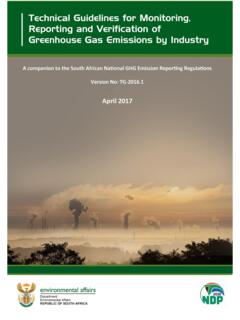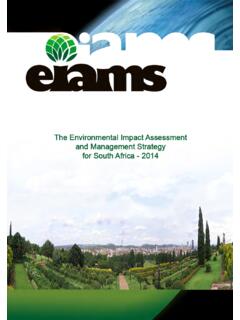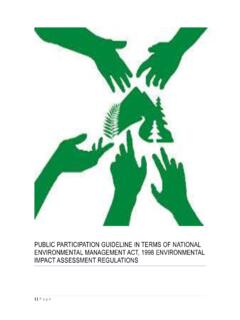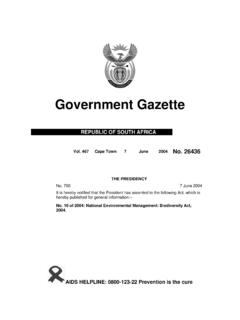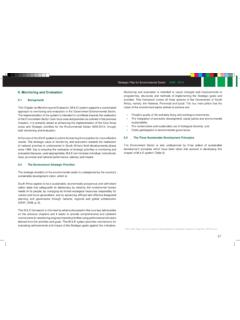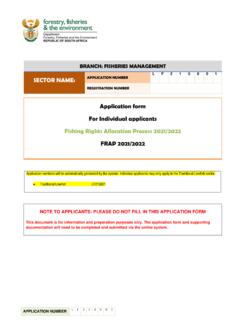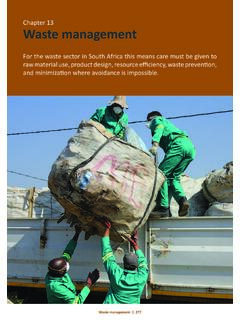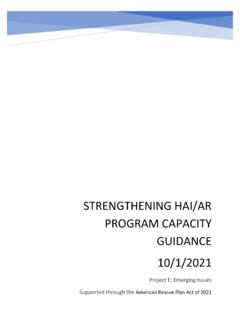Transcription of NATIONAL CLIMATE CHANGE RESPONSE
1 NATIONAL CLIMATE CHANGE RESPONSE . WHITE PAPER. environmental affairs Department: Environmental Affairs REPUBLIC OF SOUTH AFRICA. environmental NATIONAL CLIMATE affairs CHANGE RESPONSE . Department: WHITE PAPER. Environmental Affairs REPUBLIC OF SOUTH AFRICA. TABLE OF CONTENTS. LIST OF ABBREVIATIONS .. 4. EXECUTIVE SUMMARY .. 5. 1. INTRODUCTION .. 8. 2. NATIONAL CLIMATE CHANGE RESPONSE OBJECTIVE .. 11. 3. PRINCIPLES .. 12. 4. THE SOUTH AFRICAN CLIMATE CHANGE RESPONSE STRATEGY .. 13. Overall Approach .. 13. Strategic Priorities .. 14. 5. ADAPTATION .. 16. Overall Approach .. 16. Water .. 17. Agriculture and Commercial Forestry .. 18. Health .. 19. Biodiversity And Ecosystems .. 20. Human Settlements Urban Settlements.
2 21. Human Settlements Rural Settlements .. 22. Human Settlements Coastal Settlements .. 23. Disaster Risk Reduction and Management .. 24. 6. MITIGATION .. 25. Overall Approach to Mitigation .. 25. South Africa's Emissions .. 26. Mitigation Potential .. 26. The Benchmark NATIONAL GHG Emissions Trajectory Range .. 27. The Carbon Budget Approach .. 28. Sectoral Mitigation and Lower-Carbon Development Strategies .. 28. Ghg Emissions Inventory .. 29. 7. MANAGING RESPONSE MEASURES .. 30. 2. 8. NEAR-TERM PRIORITY FLAGSHIP PROGRAMMES .. 31. The CLIMATE CHANGE RESPONSE Public Works Flagship Programme .. 31. The Water Conservation and Demand Management Flagship Programme .. 31. The Renewable Energy Flagship Programme.
3 31. The Energy Efficiency and Energy Demand Management Flagship Programme .. 32. The Transport Flagship Programme .. 32. The Waste Management Flagship Programme .. 32. The Carbon Capture and Sequestration Flagship Programme .. 32. The Adaptation Research Flagship Programme .. 33. 9. JOB CREATION .. 34. Policy Outcomes .. 34. Policy Instruments .. 34. Timing of Interventions .. 35. 10. MAINSTREAMING CLIMATE -RESILIENT DEVELOPMENT .. 36. Policy and Planning Review and Regulatory Audits .. 36. Roles and Institutional Arrangements .. 36. Partnering with Stakeholders .. 38. Coordination Mechanisms .. 39. Communication and Behaviour CHANGE .. 39. Regulatory Measures .. 40. Market-Based Instruments.
4 40. 11. RESOURCE MOBILISATION .. 43. Finance .. 43. Education .. 45. Science and Technology Development .. 45. 12. MONITORING AND EVALUATION .. 47. Monitoring CLIMATE CHANGE .. 47. Medium- and Long-Term Modelling .. 47. Monitoring Responses .. 48. 13. CONCLUSION .. 49. 3. LIST OF ABREVIATIONS. CDM Clean Development Mechanism DBSA Development Bank of Southern Africa DoE Department of Energy DEA Department of Environmental Affairs DST Department of Science and Technology DTI Department of Trade and Industry GDP Gross Domestic Product GHG Greenhouse gas GHGs Greenhouse gases IGCCC Intergovernmental Committee on CLIMATE CHANGE IMCCC Inter-Ministerial Committee on CLIMATE CHANGE IPCC Intergovernmental Panel on CLIMATE CHANGE IRP 2010 Integrated Resource Plan for Electricity Generation 2010.
5 MDGs Millennium Development Goals MRV Measure, report and verify NCCC NATIONAL Committee on CLIMATE CHANGE NEDLAC NATIONAL Economic Development and Labour Council NEMA NATIONAL Environmental Management Act NEVA NATIONAL Employment Vulnerability Assessments NEVB NATIONAL Employment Vulnerability Baseline NGO Non-Governmental Organisation NGP New Growth Path NRF NATIONAL Research Foundation SAAQIS South African Air Quality Information System SARVA South African Risk and Vulnerability Atlas SETA Sector Education and Training Authority SJRPs Sector Jobs Resilience Plans UNFCCC United Nations Framework Convention on CLIMATE CHANGE 4. Executive Summary EXECUTIVE SUMMARY. CLIMATE CHANGE is already a measurable reality and along to be addressed in sector plans.
6 The process will also with other developing countries, South Africa is especially identify the adaptation responses that require coordination vulnerable to its impacts. This White Paper presents the between sectors and departments and it will be reviewed South African Government's vision for an effective CLIMATE every five years. For the immediate future, sectors that CHANGE RESPONSE and the long-term, just transition to a need particular attention are water, agriculture and forestry, CLIMATE -resilient and lower-carbon economy and society. health, biodiversity and human settlements. Resilience South Africa's RESPONSE to CLIMATE CHANGE has two objectives: to CLIMATE variability and CLIMATE CHANGE -related extreme weather events will be the basis for South Africa's future Effectively manage inevitable CLIMATE CHANGE impacts approach to disaster management and we will use region- through interventions that build and sustain South wide approaches where appropriate.
7 Africa's social, economic and environmental resilience and emergency RESPONSE capacity. Section 5 expands on the adaptation part of the RESPONSE policy. Make a fair contribution to the global effort to stabilise greenhouse gas (GHG) concentrations South Africa's approach to mitigation, which is addressed in the atmosphere at a level that avoids dangerous by section 6 of the RESPONSE policy, balances the country's anthropogenic interference with the CLIMATE system contribution as a responsible global citizen to the within a timeframe that enables economic, social international effort to curb global emissions with the and environmental development to proceed in a economic and social opportunities presented by the sustainable manner.
8 Transition to a lower-carbon economy as well as with the requirement that the country successfully tackles the This RESPONSE is guided by principles set out in the development challenges facing it. Constitution, the Bill of Rights, the NATIONAL Environmental Management Act, the Millennium Declaration and the The key elements in the overall approach to mitigation United Nations Framework Convention on CLIMATE will be: CHANGE . These principles are detailed in section 3. Using a NATIONAL GHG Emissions Trajectory Range, The overall strategic approach for South Africa's CLIMATE against which the collective outcome of all mitigation CHANGE RESPONSE is needs driven and customised; actions will be measured.
9 Developmental; transformational, empowering and participatory; dynamic and evidence-based; balanced and Defining desired emission reduction outcomes cost effective; and integrated and aligned. for each significant sector and sub-sector of the economy based on an in-depth assessment of the In terms of strategic priorities, the White Paper sets out mitigation potential, best available mitigation options, South Africa's CLIMATE CHANGE RESPONSE strategy to achieve science, evidence and a full assessment of the costs the NATIONAL CLIMATE CHANGE RESPONSE Objective in a and benefits;. manner consistent with the outlined principles and approach Adopting a carbon budget approach to provide for and which is structured around the following strategic flexibility and least-cost mechanisms for companies priorities: risk reduction and management; mitigation in relevant sectors and/or sub-sectors and, where actions with significant outcomes; sectoral responses.
10 Appropriate, translating carbon budgets into company policy and regulatory alignment; informed decision making level desired emission reduction outcomes. and planning; integrated planning; technology research, development and innovation; facilitated behaviour CHANGE ; Requiring companies and economic sectors or behaviour CHANGE through choice; and resource mobilisation. sub-sectors for which desired emission reduction outcomes have been established to prepare and See section 4 for details of the elements of the RESPONSE submit mitigation plans that set out how they intend policy. to achieve the desired emission reduction outcomes. In terms of adaptation, the NATIONAL CLIMATE CHANGE Developing and implementing a wide range and RESPONSE includes a risk-based process to identify and mix of different types of mitigation approaches, prioritise short- and medium-term adaptation interventions policies, measures and actions that optimise the 5.
